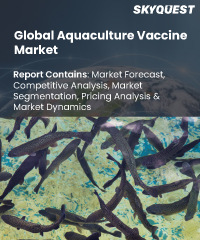
Report ID: SQMIG35J2053

Report ID:
SQMIG35J2053 |
Region:
Global |
Published Date: February, 2024
Pages:
242
|
Tables:
94 |
Figures:
76
Aquaculture Vaccine Market size was valued at USD 199.63 million in 2019 and is poised to grow from USD 214.6 million in 2023 to USD 384.64 million by 2031, growing at a CAGR of 7.6% in the forecast period (2024-2031).
Owing to the rise in the cases of bacterial and viral illnesses among aquaculture species, there will be expansion of aquaculture production globally, and the rise in the use of vaccines by aquaculture producers. Innovative vaccines being developed and released to treat various viral illnesses in aquaculture species is supporting the market's revenue growth. For instance, in Greece, the Icthiovac VR/PD injectable vaccine against Vibriosis and Pasteurellosis was introduced by Hipra in March 2018. In addition to the aforementioned characteristics, the market will see growth during the projected years due to increased funding for the study and development of novel aquaculture vaccines.
The market is anticipated to be driven by increased aquaculture output, a high incidence of infectious illnesses in the aquaculture industry, and rising consumer demand for food items produced from aquatic animals. The market has seen a shift away from live attenuated vaccines toward DNA vaccines, and it is quickly embracing recombinant vaccines as well. A large number of influential players in the aquaculture vaccines industry as well as other areas of the animal and human health industries redirected their resources to produce essential goods and supplies. For instance, Zoetis revealed during the publication of its Q3 earnings that its sales increased by 13% from the same period the year before. The recently released parasiticide for companion animals and Zoetis' important dermatological portfolio were the main drivers of performance.
Around 219 instances of infectious illnesses were reported in the fresh aquaculture sector between 2016 and 2019, according to the Aquaculture Research & Development journal. The majority (74.88%) of these cases (7.80%) were caused by parasites, 12.80% by bacteria, 1.83% by viral, and 10.50% by a combination of parasitic and bacterial infections. Consequently, it is anticipated that such a high frequency of infectious illnesses would increase the need for vaccinations, thereby boosting market development.
US Aquaculture Vaccine Market is poised to grow at a sustainable CAGR for the next forecast year.
Our industry expert will work with you to provide you with customized data in a short amount of time.
REQUEST FREE CUSTOMIZATIONAquaculture Vaccine Market size was valued at USD 199.63 million in 2019 and is poised to grow from USD 214.6 million in 2023 to USD 384.64 million by 2031, growing at a CAGR of 7.6% in the forecast period (2024-2031).
Want to customize this report? This report can be personalized according to your needs. Our analysts and industry experts will work directly with you to understand your requirements and provide you with customized data in a short amount of time. We offer $1000 worth of FREE customization at the time of purchase.

Report ID: SQMIG35J2053